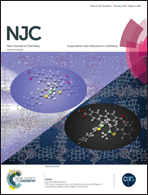The contribution of polar C–H hydrogen bonds to anion binding†
Abstract
The contribution of C–H hydrogen bonds is one of the key factors to consider in anion binding receptor design. To investigate the participation of C–H hydrogen bonds through C–H polarization in an anion binding event, we have designed and synthesized three new anion receptors (receptors 1, 2 and 3). Essentially, the only difference between these receptors is the relative magnitude of the C–H(Ha) polarization. These receptors utilize two amide N–H, two aromatic C–H(Ha), anthracene 9-C–H and possibly two methyl groups as hydrogen bonding moieties. From the titrations and DFT calculations, we found that the anion binding abilities of these receptors mainly depend on the magnitude of the polarization of C–H(Ha) and receptors 1 and 2 are selective for H2PO4−.


 Please wait while we load your content...
Please wait while we load your content...